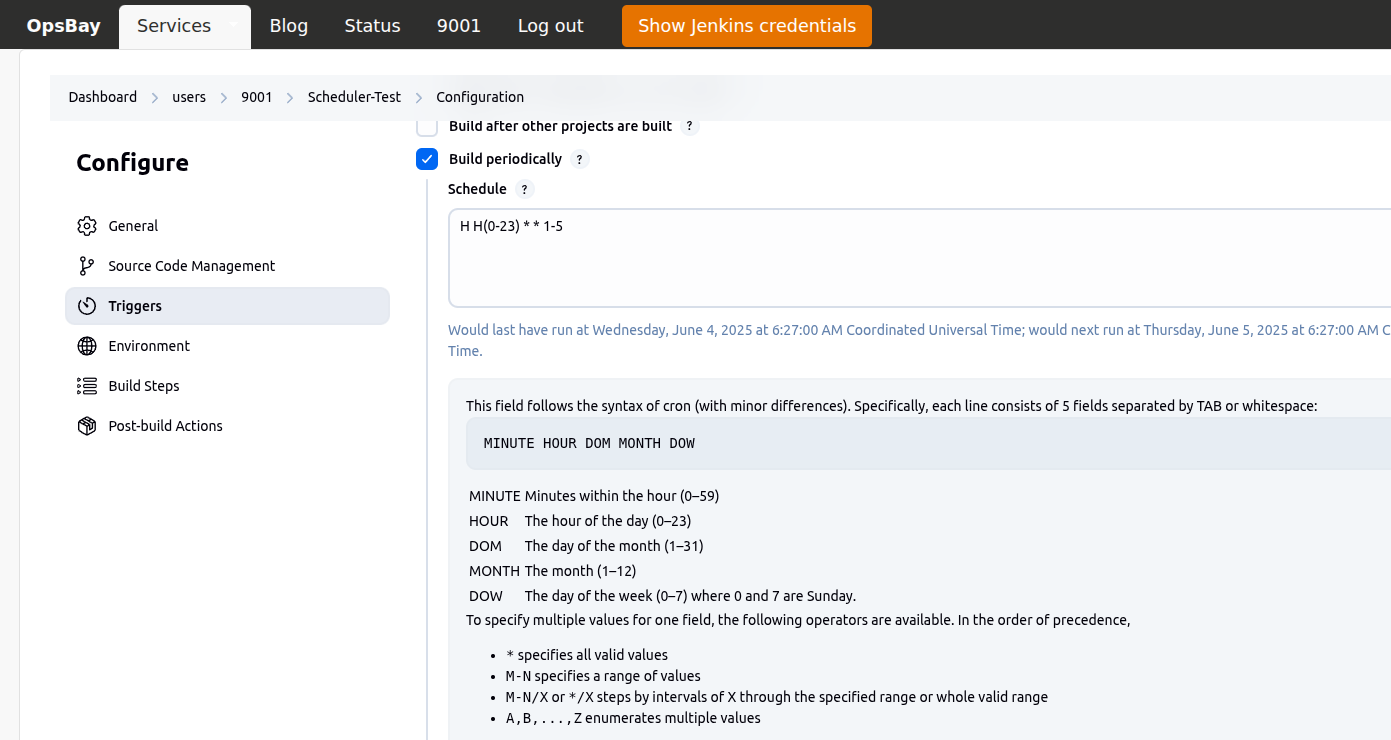Submitted by itefix on

At OpsBay, we're all about optimizing operations and finding smart ways to manage complex tasks. While Jenkins is universally celebrated as the bedrock of Continuous Integration and Continuous Delivery (CI/CD), its capabilities extend far beyond automated builds and deployments. Today, we want to shine a light on an often-underutilized, yet incredibly powerful, aspect of Jenkins: its potential as a convenient and robust job scheduler.
Why Jenkins for Scheduling?
You might be thinking, "Don't we have cron for that?" And you're right, cron is a fantastic tool for simple, time-based tasks. However, when your operational needs grow beyond the basics, Jenkins offers a compelling suite of advantages that make it a superior choice for a wide range of scheduling scenarios:
- Centralized Management: Instead of scattered
cronjobs across multiple servers, Jenkins provides a single, web-based interface to manage all your scheduled tasks. This offers unparalleled visibility and control. - Robust Error Handling and Notifications: Jenkins excels at reporting job status. You can configure email notifications, Slack alerts, or even trigger other jobs based on success or failure, ensuring you're always in the loop.
- Rich Plugin Ecosystem: The sheer breadth of Jenkins plugins allows you to do almost anything. Need to schedule a Python script that interacts with an API? Or a shell script that performs database backups? Or a task that pushes data to a cloud storage bucket? There's likely a plugin to streamline the process.
- Version Control for Jobs: Jenkins job configurations can be managed as code (e.g., using Job DSL or Pipeline as Code), allowing you to version control your scheduled tasks, track changes, and easily roll back if needed.
- Parameterized Builds: Need to run the same task with different inputs? Jenkins allows you to define parameters for your jobs, making them highly reusable and flexible.
- Distributed Execution: For heavy workloads, Jenkins can distribute scheduled tasks across multiple agent nodes, preventing bottlenecks and maximizing efficiency.
- Historical Data and Logging: Every job execution in Jenkins is logged, providing a detailed history of when a task ran, its output, and its status. This is invaluable for auditing, troubleshooting, and performance analysis.
- Triggering Flexibility: Beyond simple time-based triggers, Jenkins offers a variety of ways to initiate jobs, including:
- Poll SCM: Trigger a job when changes are detected in a source code repository (though more common for CI/CD, still useful for data synchronization tasks).
- Upstream/Downstream Projects: Chain jobs together, so one task automatically triggers another upon completion.
- Remote Triggers: Initiate jobs via API calls from external systems.
Practical Use Cases for Jenkins as a Scheduler
Let's look at some real-world examples where Jenkins shines as a scheduler:
- Automated Data Backups: Schedule daily, weekly, or monthly backups of databases, file systems, or cloud storage.
- Report Generation: Automate the creation and distribution of daily, weekly, or monthly business reports.
- System Maintenance Tasks: Schedule routine tasks like log rotation, temporary file cleanup, or server health checks.
- Data Synchronization: Regularly sync data between different systems or databases.
- Pre-production Environment Refreshes: Automate the process of refreshing development or staging environments with production data.
- Ad-hoc Script Execution: Need to run a specific script on a schedule without setting up a full CI/CD pipeline? Jenkins is perfect for this.
- API Calls and Integrations: Schedule tasks to interact with external APIs for data retrieval, updates, or notifications.
Getting Started: Scheduling Your First Task in Jenkins
If you're already familiar with creating Jenkins jobs, setting up a scheduled task is straightforward.
-
Create a New Item (Job): Choose a "Freestyle project," "Pipeline," or other relevant job type.
-
Configure Your Task: In the "Build" section, add the necessary build steps (e.g., "Execute shell," "Execute Windows batch command," or call a pipeline script). This is where you put the commands or scripts you want to run.
-
Set the Build Trigger:
- Scroll down to the "Build Triggers" section.
- Check "Build periodically."
- In the "Schedule" text area, enter your cron-style schedule string.
Examples of Cron Schedules:
H 0 * * *(Every day at midnight)H H(0-23) * * 1-5(Every hour on weekdays)H H 1 * *(First day of every month)H 22 * * 0(Every Sunday at 10 PM)
(Note: Using 'H' for "hash" or "randomized" helps spread out builds and avoid thundering herds if you have many jobs scheduled for the same time.)
-
Save and Monitor: Save your job and observe its execution in the Jenkins dashboard. You'll see the history of runs, logs, and any configured notifications.
Best Practices for Jenkins Scheduling
- Idempotency: Design your scheduled tasks to be idempotent, meaning running them multiple times has the same effect as running them once. This prevents issues if a job is accidentally triggered twice.
- Resource Management: Be mindful of the resources your scheduled jobs consume. If you have many heavy tasks, consider using Jenkins agents to distribute the load.
- Logging and Monitoring: Ensure your scripts produce clear logs, and leverage Jenkins' built-in logging and notification features.
- Error Handling: Implement robust error handling within your scripts and configure Jenkins to notify you of failures immediately.
- Security: Follow Jenkins security best practices, especially when dealing with sensitive data or credentials in your scheduled tasks.
- Documentation: Document your scheduled jobs, their purpose, their schedule, and any dependencies.
Conclusion
While Jenkins is a CI/CD powerhouse, its flexibility and rich feature set make it an equally compelling solution for a wide array of operational scheduling needs. By centralizing your tasks, leveraging its robust error handling, and tapping into its vast plugin ecosystem, you can transform your operational efficiency.
So, next time you think about scheduling a task, consider giving Jenkins a try. You might just discover a new favorite tool for keeping your operations running smoothly and predictably.